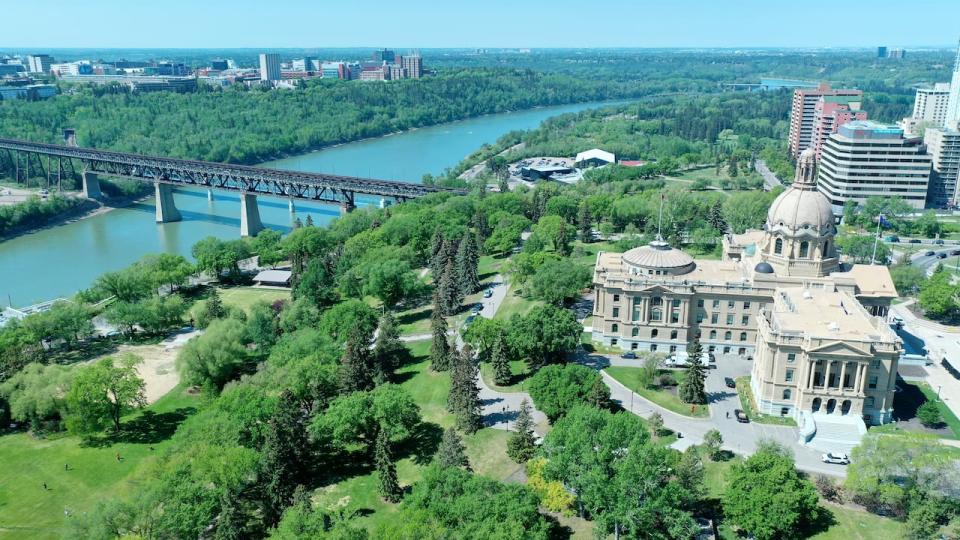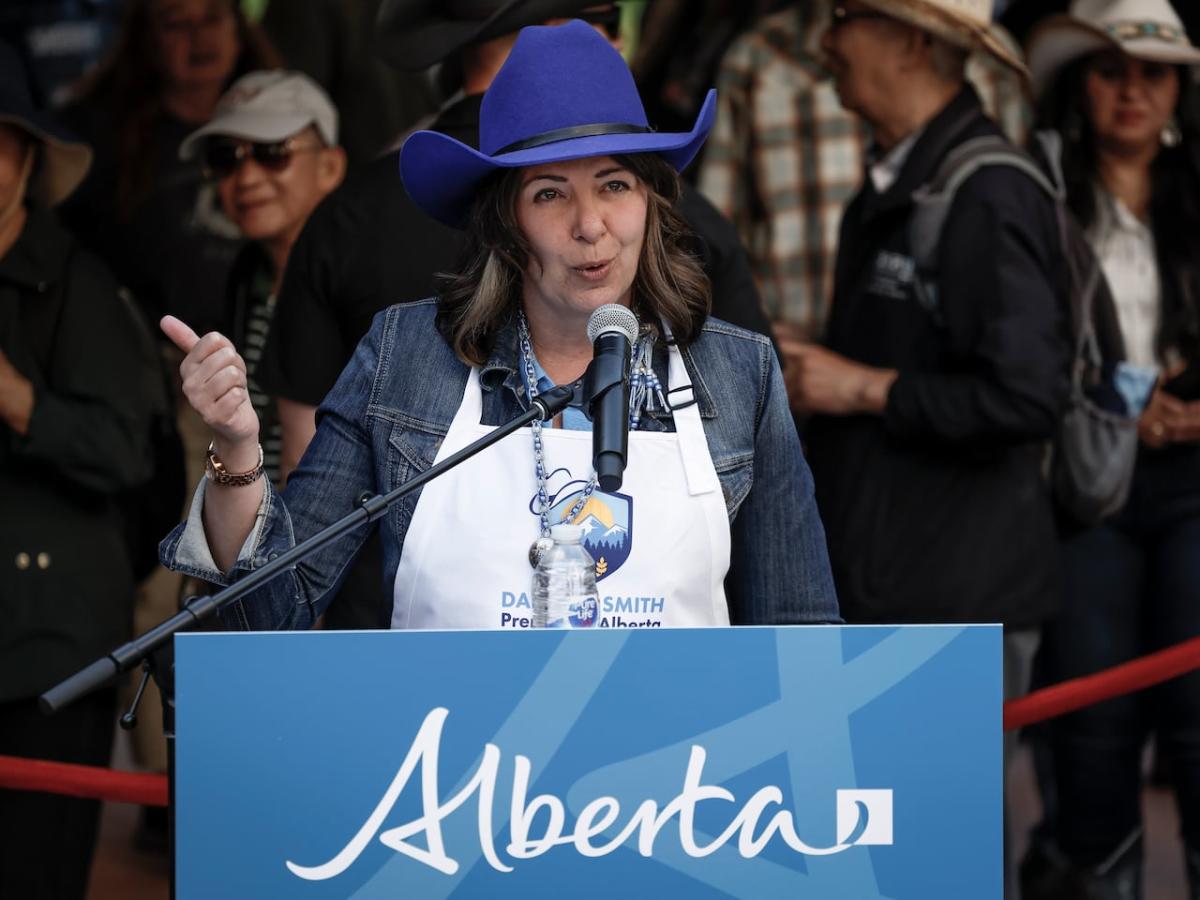Premier Danielle Smith realizes her United Conservatives have an urban problem, having lost every seat in Edmonton last election and a majority of ridings in Calgary to the NDP.
“Why do people become socialist when they move to Calgary and Edmonton? I just don’t get it,” she quipped at a UCP town hall earlier this month, in the more conservative-friendly town of Drayton Valley.
If she perceives her problem as a broad and attitudinal one like that — though her office insists she was making an “off-the-cuff joke” calling urbanites socialist — one of her proposed solutions might be roughly as expansive.
Smith would like to stoke more population growth in the less urbanized parts of the province. And it seems she’s interested in doing so by moving more of the government’s bureaucracy outside of the capital city and Calgary.
“Some of the advice we’ve been given is why don’t we start moving some of those departments out into rural Alberta,” she told the crowd. “Why is Agriculture in Edmonton? Agriculture should be in rural Alberta.”
She also mused about Alberta Energy not necessarily needing to be split between Calgary and the capital, rather than where oil and gas are extracted.
“There’s some departments that might actually make sense to have a stronger presence in the regions and less of a concentration in Edmonton. So that’s another thing that we’re contemplating.”
RE:location
It’s common for governments to move agencies or divisions outside of the provincial capital. Alberta’s gaming and liquor regulator is headquartered in St. Albert, and the Agriculture Financial Services Corporation’s central office is in the central town of Lacombe.
Federally, a Natural Resources Canada energy research centre is located in Devon, Alta., a large Agriculture Canada research complex is in Lethbridge, while the immigration department’s citizenship processing centre was moved last decade to Edmonton from the town of Vegreville. Alta.
But when they do this, governments typically locate such offices to either be strategic — like putting the federal energy regulator in downtown Calgary — or in the name of boosting economic development in a different region.

Premier Danielle Smith, right, has spent much of August at UCP members-only meetings and fundraisers, including an event this week in Slave Lake with Scott Sinclair, left, and Brandon Lunty. (ABDanielleSmith/X)
It would seem unorthodox for a premier to plot such moves to create a partisan demographic advantage. That appears to help form Smith’s motivation, based on her lengthy answer to a UCP member’s question about the party’s struggles winning in cities.
In her response, she admits new NDP Leader Naheed Nenshi, a former Calgary mayor, will be “difficult” and the election in the cities will be a “big battle.”
The premier despairs of the NDP’s sweep of Edmonton and worries Calgary might be headed in that direction. “How did that happen?” she wondered. “How did Calgary all of a sudden become NDP?”
(It wasn’t anomalous. The 2023 outcome is the second time Calgary voted in a majority of NDP members, after Rachel Notley’s 2015 victory.)
Smith told the UCP crowd her party needs to figure out its urban strategy, and suggested fixing the health-care system as its pillar.
But she then delved into more blue-sky thinking. She did so with what sounded like some trepidation. She’s faced some pushback from her base recently about her past big idea to rapidly double Alberta’s population to 10 million.
“We also need to — I think, but I don’t know how you feel about it — but have more people settle into the mid- and small towns,” Smith said.
“Because there’s something that you guys do, too. You bring a socialist out from the East and you bring them to Drayton Valley and all of a sudden they’re conservative.”
Would relocating program analysts and food scientists so quickly transform their politics, or the political map for Smith’s party? Any demographic shift would likely be a long game for the UCP.
Redrawing boundaries
Alberta will likely start the occasional and multi-partisan process to redraw riding boundaries this fall. This upcoming one would only measure past population increases, the ones that continue to concentrate more of Alberta’s population growth in the Edmonton and Calgary regions.
Smith has previously tipped her interest in bringing more growth to other areas, like her frequent musings about a million-person Red Deer (where, incidentally, voters currently prefer UCP).
It’s easy to imagine a pitch to relocate Alberta’s bureaucracy would have similar levels of drama to it, especially potential pushback from existing staff if she relocates entire departments.
Governments may move some offices away from the capital, but even the agriculture department headquarters of places like Saskatchewan, Montana and North Dakota are in their respective legislature’s city, for proximity to the rest of the civil service and their political masters. (Kansas is an exception, basing its ag department in a town one hour’s drive from the capital of Topeka.)
Also, the types of numbers involved in relocating public sector workers doesn’t exactly promise seismic demographic or political shifts, whatever the motivation.
While 60 per cent of Alberta government employees work in Edmonton and 16 per cent are in Calgary, according to Alberta Finance — the rest scattered to prisons, courthouses, Alberta Parks offices and the like elsewhere — the entire provincial government workforce numbers only around 29,000, a mere sliver in a 4.8-million person province.


Around 60 per cent of the provincial government’s workforce is based in the capital city, according to Alberta Finance. (David Bajer/CBC)
Asked what plans the Smith government has to send ministry staff farther afield, spokesperson Sam Blackett said: “Alberta’s government is always looking at ways to optimize the public service.
“At this time, no decisions have been made to relocate any departments.”
If this never becomes actual Smith government policy — if Albertans can chalk this up to another mere ponderance from a former talk-show host — this at least appears to provide some insight into how Smith thinks about using levers of government to produce partisan advantages for her side.
And if this does turn out to be the first inkling of a premier’s strategy to refocus population growth and civil service to smaller towns?
Smith may produce more traditional justifications for moving provincial offices outside the capital, like strategy or economic development. But Albertans will have first heard her touting these ideas to a UCP audience, for potential UCP benefit.
That may become a hard idea to shake, particularly for any Edmonton bureaucrat who one day may be told the province is moving their job to Sundre or Whitecourt.

